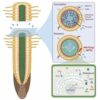A new study by a team of researchers from Israel and Ghana has brought the first evidence of nonrandom mutation in human genes, challenging a core assumption at the heart of evolutionary theory by showing a long-term directional mutational response to environmental pressure. Using a novel method, researchers led by Professor Adi Livnat from the University of Haifa showed that the rate of generation of the HbS mutation, which protects against malaria, is higher in people from Africa, where malaria is endemic, than in people from Europe, where it is not.
“For over a century, the leading theory of evolution has been based on random mutations. The results show that the HbS mutation is not generated at random but instead originates preferentially in the gene and in the population where it is of adaptive significance,” said Prof. Livnat. Unlike other findings on mutation origination, this mutation-specific response to a specific environmental pressure cannot be explained by traditional theories. “We hypothesize that evolution is influenced by two sources of information: External information that is natural selection, and internal information that is accumulated in the genome through the generations and impacts the origination of mutations,” said Livnat.
Ever since Darwin we have known that life arose by evolution. But how, exactly, does evolution—in all its grandeur, mystery and complexity—happen? For the past century scientists have assumed that mutations occur by accident to the genome and that natural selection, or the survival of the fittest, favors beneficial accidents. The accumulation of these presumed genetic accidents under natural selection over the millennia leads in turn to adaptations, from the hawk’s sharp eye to the human cardiovascular system.
While widely held in the scientific community, this view has always left open fundamental questions, such as the problem of complexity. Can the sequential accumulation of small random changes, each beneficial on its own, lead within the timespan available to the evolution of such astonishingly complex and impressive adaptations as we see around us in nature, such as eyes, brains or wings, where complementary parts interweave into a complex whole? However, the only alternative at the fundamental level conceived of up until now consisted of variants of Lamarckism—the idea that organisms can somehow respond directly to their immediate environments with beneficial genetic change. Since Lamarckism has not worked in general, the notion of random mutation remained the prevailing view.
In order to distinguish between the random mutation and natural selection explanation and the possibility that nonrandom mutation is important, Prof. Livnat and his lab manager, Dr. Daniel Melamed, developed a new method for detecting de novo mutations—mutations that arise “out of the blue” in offspring without being inherited from either parent. In breaking a new accuracy record, their method allowed something not previously possible—counting of de novo mutations for particular points of interest in the genome.
They then applied their method to examine the de novo emergence of the human hemoglobin S (HbS) mutation, perhaps the most well known point mutation in biology and evolution. HbS provides protection against malaria for people with one copy but causes sickle-cell anemia in those with two. Malaria itself, a vector-borne blood disease, has arguably been the strongest selection pressure acting on humans in the last 10,000 years, often causing more than a million deaths per year in Africa in the recent past. HbS is also used as a central example of random mutation and natural selection in evolution: It has been long assumed to have arisen accidentally in an individual in sub-Saharan Africa and then spread inside Africa via natural selection until its malaria-protective benefits were balanced out by its sickle-cell anemia costs.
By examining the de novo origination of HbS, Livnat was able to disentangle for the first time whether the malaria-protective mutation arises randomly and spread in Africa only because of selection pressure or instead whether it could actually be originating de novo more frequently in sub-Saharan Africans—a group that has been subject to intense malarial selection pressure for many generations. If the mutation is random, then it should be equally likely to emerge in both geographical groups. However, if mutation is nonrandom, then perhaps it would actually emerge more frequently in Africans.
“There are at least two possible reasons why such a question had not been asked before,” explains Prof. Livnat. “First, it had been assumed that mutation is random. Second, even if one had wanted to ask such a question, it would not have been possible with previous methods.”
Contrary to the widely accepted expectations, the results supported the nonrandom pattern. The HbS mutation originated de novo not only much faster than expected from random mutation, but also much faster in the population (in sub-Saharan Africans as opposed to Europeans) and in the gene (in the beta-globin as opposed to the control delta-globin gene) where it is of adaptive significance. These results upend the traditional example of random mutation and natural selection, turning it into an example of a nonrandom yet non-Lamarckian mutation.
“Mutations defy traditional thinking. The results suggest that complex information that is accumulated in the genome through the generations impacts mutation, and therefore mutation-specific origination rates can respond in the long-term to specific environmental pressures,” said Prof. Livnat. Previous studies, motivated by Lamarckism, only tested for an immediate mutational response to environmental pressures. “Mutations may be generated nonrandomly in evolution after all, but not in the way previously conceived. We must study the internal information and how it affects mutation, as it opens the door to evolution being a far bigger process than previously conceived,” Livnat concluded.
Until now, investigators have been limited by technology to measuring mutation rates as averages across many positions in the genome. Overcoming this barrier, the new method developed by Livnat and Melamed allowed the HbS mutation to be the first to have its mutation-specific origination rate measured, opening up new vistas for studies on mutation origination. These studies have the potential to affect not only our fundamental understanding of evolution, but also our understanding of diseases that are caused by mutations, namely genetic disease and cancer.
The article was accepted in the scientific journal Genome Research and appears in an advance online form.
More information:
Daniel Melamed et al, De novo mutation rates at the single-mutation resolution in a human HBB gene-region associated with adaptation and genetic disease, Genome Research (2022). DOI: 10.1101/gr.276103.121
Provided by
University of Haifa
Citation:
Study uncovers first evidence of long-term directionality in origination of human mutation, challenging neo-Darwinism (2022, January 31)



